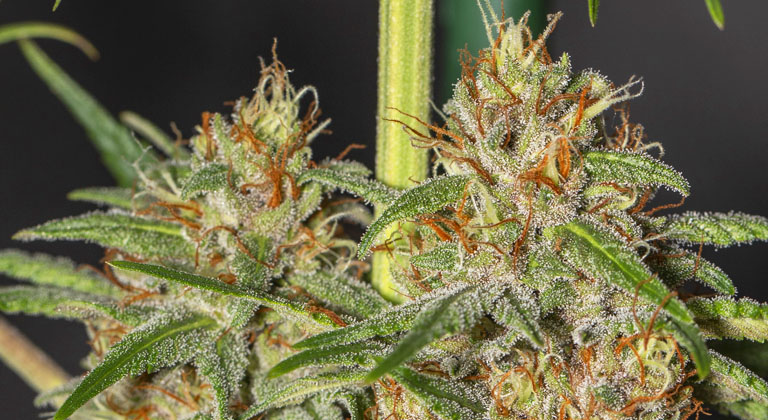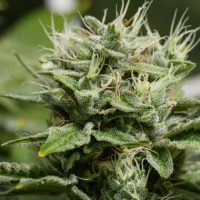There are many different types of cannabis pruning techniques with which the quality and yield of cannabis plants can be easily improved. Some methods are more suited for indoor grows, whereas others are more suited for outdoor grows.
Plus, not all cannabis plants react the same way to the same type of cannabis pruning techniques. There are strains that, due to how they grow, aren’t recommended for certain types of pruning techniques. Also, there is an ideal time to prune cannabis plants and for each type of prune, which is important to keep in mind for successful results. In this post we’re going to illustrate all of the details you need to know about these pruning techniques used on cannabis plants.
What is Pruning?
Pruning is an agricultural practice with centuries of history behind it, and consists of cutting branches in a specific way to direct the growth of the plant, increasing its final yield. This practice can also be applied to cannabis plants to increase bud yield.
Each cannabis strain has a different growth pattern, so it’s important to choose the cannabis pruning technique that best suits the strain selected for growing, and the conditions of the grow itself. When planning a grow, these techniques should be considered, and if any pruning is applied, it is advisable to choose not only a method that suits the strain but also the one that matches your grow’s needs.
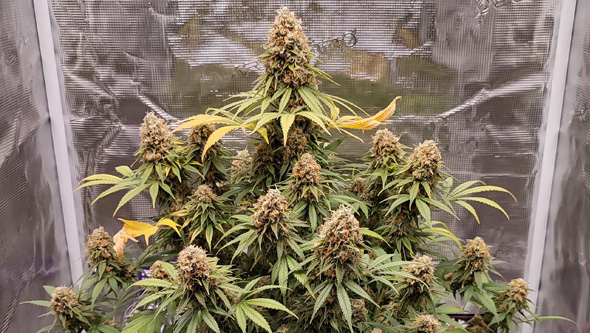
What Tools are Needed to Prune Cannabis?
To apply this technique, a cutting tool is needed, such as bonsai scissors or classic round or flat-tipped scissors, which are used in most types of pruning. It’s important that they are kept sharp, as tearing plant tissues can cause unnecessary stress. They should also be kept clean to minimize the transfer of viral diseases, which are not very common but can still occur.
In some cases, more precision may be required than what a pair of scissors can provide, such as when pruning very small branches or when applying apical or FIM pruning. In these cases, it’s recommended to use a scalpel to obtain a precise and clean cut that doesn’t damage the plant.
It’s also very important that pruning tools are well sanitized at all times; alcohol for disinfection is essential.
Some cannabis pruning and bending techniques may also require the use of plastic-coated flat wire and trellis netting, as well as circular or vertical stakes to guide the plant, support the branches, and channel the plant’s strength towards more bud yield.
For bending techniques, materials such as electrical tape, adhesive fabric, duct tape, or packing tape may be needed to recover and protect broken branches in case of breakage when bent. This happens quite often, so we recommend keeping basic tools in your cannabis toolbox at all times.
In summary, the basic tools needed to prune cannabis, as well as for practically any other soft-stemmed plant, are:
- Sharp scissors or a scalpel (the most essential)
- Alcohol
- Wire or stakes
- Adhesive tape
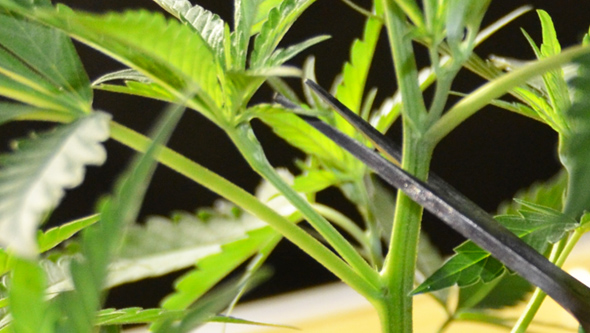
Types of Cannabis Pruning Techniques
There are several cannabis pruning techniques that can be applied to cannabis, and each one is better suited for a different set of needs. Let’s have a look:
Apical Pruning
This is one of the simplest and most commonly used cannabis pruning techniques. In reality, all types of prune could be considered apical, although apical pruning is commonly treated as a unique technique.
What is apical pruning?
At the top of the plant, there is the so-called “apical bud” or branch, where the leaves sprout attached to the main stem. There is a high concentration of auxins here, which are phytohormones that, among other functions, stop the growth of secondary branches. If this tip is cut, two stems are formed, and more attention and strength is distributed to all the secondary branches on the plant.
Apical pruning is suitable for both indoor and outdoor plants, but it requires plants that grow very strong. Normally, hybrids with a tendency towards sativa are ideal for this type of pruning technique, as they grow quickly and sturdily.
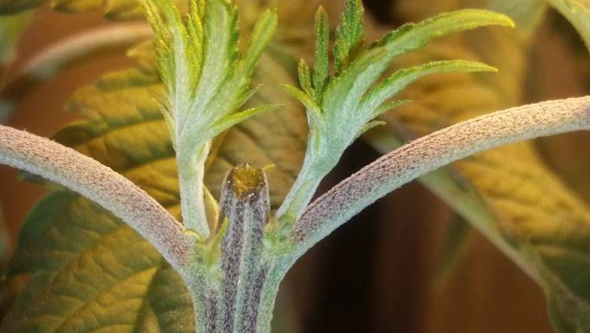
What are the advantages of apical pruning?
- The goal is to achieve more branches with buds that have more balanced access to indoor lighting.
- It also helps to change the plant’s morphology and make it more bushy, which is beneficial for discreet yet highly productive outdoor grows, as well as for creating a plant that is easier to care for but equally as, or even more, productive, depending on the strain.
How to use the Apical Pruning Method on Cannabis Plants?
Apex pruning should be applied at least from the third node counted from the bottom up, never before, and always during the growth phase. In outdoor grows, it can be done until mid or late June in the northern hemisphere, and until mid or late December in the southern hemisphere. It should be noted that the longer the plant has to keep growing and developing after pruning, the more effective it will be.
Apical pruning should never be done during flowering or close to the start of the flowering period, as it will reduce yield and the benefits of this method will have been for nothing.
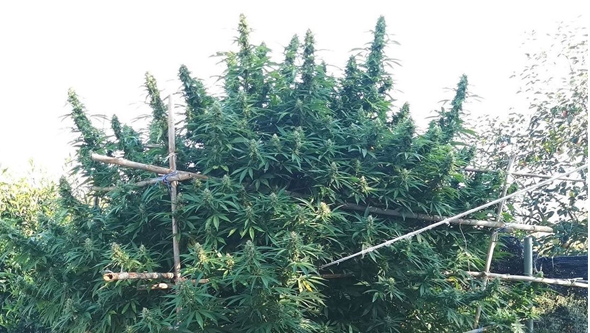
Lollipop Pruning
Unlike apical pruning, lollipop pruning focuses all the plant’s strength on the upper third, discarding unproductive branches.
What is lollipop pruning?
Lollipop pruning consists of removing unproductive branches so that all the plant’s strength is directed towards the branches that produce buds. This type of pruning is straightforward, but having some experience is crucial to be able to know and identify the branches that should be cut. Of course, each strain will react differently to this pruning technique.
What are the advantages of lollipop pruning?
- Unproductive branches use nutrients that could be used for the buds and supporting branches. Lollipop pruning directs all the plant’s nutrients towards the development of larger buds and their supporting branches.
- In indoor grows, it also prevents the appearance of fungi by allowing for better air circulation.
How to Lollipop Prune Cannabis
This pruning method is done during the late growth stage and the start of the flowering period. You’ll need to identify the branches that should be cut first. Start with the smaller branches closest to the roots and stop at the chosen height, depending on your needs and preferences.
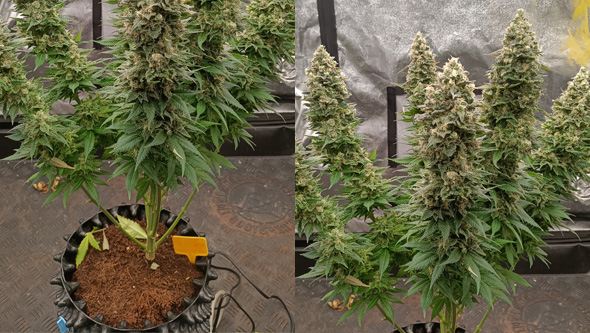
FIM Pruning
Currently, this is a widely used technique when it comes to growing cannabis and can yield very good results. It’s a simple technique that’s accessible to growers of all levels.
What is FIM pruning?
FIM pruning allows for more shoots from the same plant node. It’s a simple technique that can be used in both indoor and outdoor grows.
What are the advantages of FIM pruning?
- Increased yield.
- Reduced chances of fungal attacks in strains with dense buds, as multiple smaller buds are obtained instead of one large central bud.
- Your space can produce more yield with fewer plants..
- Similar to apical pruning, strength is distributed to secondary branches.
How to Use the FIM Pruning Technique on Cannabis
Instead of cutting the top of the plant like with apical pruning, with FIM pruning, only two-thirds of the stem is cut. After a few days, two or more shoots will sprout from the cut.
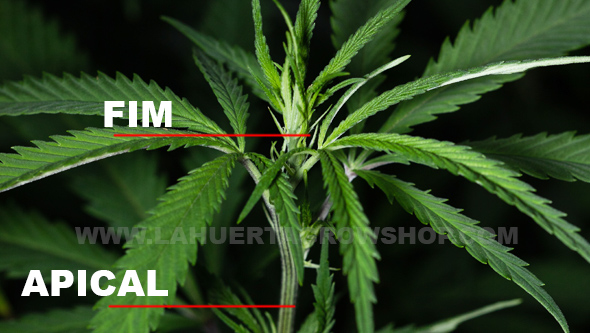
LST Pruning
If you enjoy being involved with your plants throughout the day and spending time with them, this type of pruning may be your preferred method. LST stands for Low Stress Training.
What is the LST technique?
The Low Stress Training method combines the benefits of apical pruning with bending techniques to develop the plant horizontally. It’s applicable to both outdoor and indoor grows.
What are the advantages of the LST method?
- Apical pruning results in longer and sturdier secondary branches.
- Bending techniques improve light exposure to the plant.
- More branches with sufficient light produce more buds.
How to apply the LST technique to cannabis plants
This method can be applied to all non-autoflowering feminized and regular strains. Strong and dense strains are ideal for this technique as they shorten their horizontal growth phase.
- The first step is to perform the apical pruning technique.
- From this apical pruning, two lateral branches will emerge, which should be bent and secured with gardening wire and stakes. Some growers drill holes in the edges of their pots using a drill and a fine drill bit, trying one end up.
- Vertical stems should grow from each horizontal branch, where buds will develop.
This type of pruning should start at the beginning of the growth stage, once the plant surpasses three nodes. The goal is to achieve as many well-developed lateral branches during growth as possible.
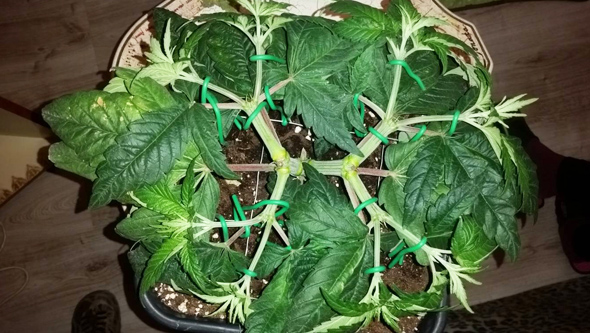
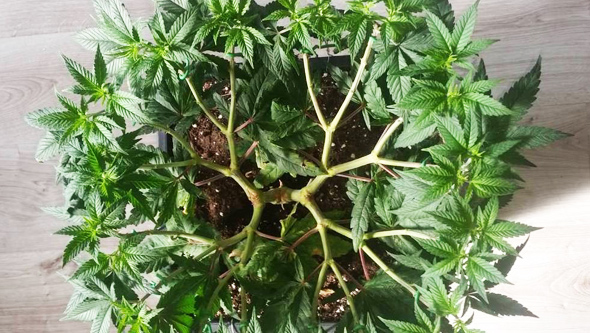
RIB Technique
RIB stands for “Right, I Burned it.” It was discovered as a technique after a mistake that ended up accidentally burning the tip of a bud.
What is RIB pruning?
It’s a technique that aims to channel the plant’s strength into healing the buds to increase calyx production.
What are the benefits of RIB pruning?
This method was born from observing plants that accidentally had the tips of their buds burned by their grow lamps.
- When the tip of the bud is burned, the plant reacts by regenerating the area with increased cell division, resulting in more calyxes forming buds without leaves.
- This technique produces larger buds.
How to apply the RIB pruning technique to Cannabis Plants?
Pure sativa strains can produce male flowers, while pure indica strains generally have a very short flowering period, so the benefits of this technique may not be fully reached with strains like these. Balanced hybrids are the best plants to benefit as much as possible from the RIB method.
To apply this technique, the plants should be at least four weeks into the flowering stage, and there should still be room for the buds to develop.
The goal is to burn only the upper part of the bud without going overboard, as excessive burning will halt its growth entirely. The burning can be done with a simple turbo lighter like the Maxim Picasso or Silver Match, or with a Minitube Clipper.
This process extends the flowering period by a few days, so suitability should be evaluated based on the type of grow you have. It’s a method that requires experience, so it is advisable to try it on one plant before applying it to the entire grow.
Super Cropping Technique
In this technique, the plant is not cut; instead, the stem is bent to improve the plant’s final yield.
What is the Super Cropping method?
It’s a way to increase production by directing the plant’s growth through bending of the branches. It’s similar to apical pruning but without cutting the stem.
What are the benefits of Super Cropping?
- It distributes auxins to the secondary branches, which develop more and produce more buds.
- By directing the tip of the plant horizontally, the stem is strengthened, and the size of the central bud increases.
- It allows better height control in indoor grow rooms and tents.
How to Supper Crop Cannabis Plants?
First, to apply this technique, select the branches that you want to bend.
Hold the stem with your thumb and index finger, press, and bend it in the desired direction. The goal is to bend it without breaking or separating it. If the stem breaks, you can use insulation tape, packing tape, or duct tape. Around the area where it is bent, it will begin to thicken, providing greater support and increasing the size of the buds.
Stem pinching or pinching
This technique distributes growth hormones throughout the branches and is the method that causes the least stress to the plant. However, it requires practice to master.
What are the advantages of stem pinching?
- Secondary branches grow stronger and are prepared to produce more flowers.
- Plants develop a bushy shape and grow horizontally. More buds of higher quality are obtained.
- The plant experiences minimal stress, ensuring its overall health.
How to pinch or prune the stem
This is a technique applied during the first half of the growth stage when the plant has more than three nodes, allowing time for branches to grow. It should be applied just below the apical bud. The procedure is simple: press the stem with your index and thumb until you hear a “crack.” This technique is a milder version of apical pruning and gentler than super cropping.
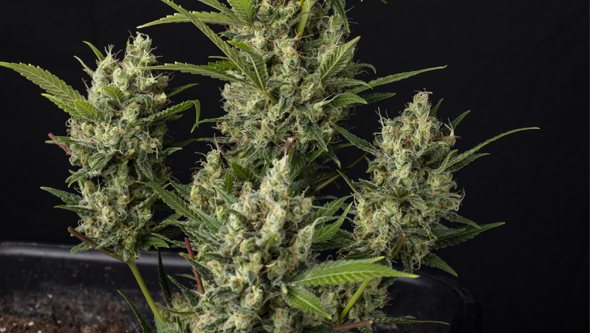
Types of pruning and autoflowering plants
Autoflowering or automatic plants are hybrids made with Ruderalis genetics, which makes them flower independently of the sunlight once they mature. In these hybrids, the growth stage is very short, ranging from 3 to 5 weeks from germination, followed by a rapid flowering stage that lasts from 5 to 7 weeks.
With such rapid growth, these plants simply won’t benefit from cannabis pruning techniques. The stress caused by these techniques can negatively affect the results obtained from your grow. It’s recommended to have a good understanding of the strain by growing it a couple of times without pruning to fully understand how it grows.
What do you think of this post? Do you have any questions? Would you like to share your opinion? Let us know below!
La Huerta Grow Shop!
